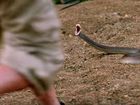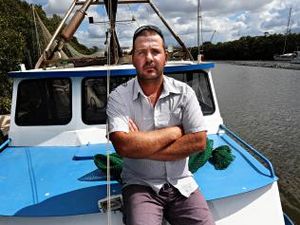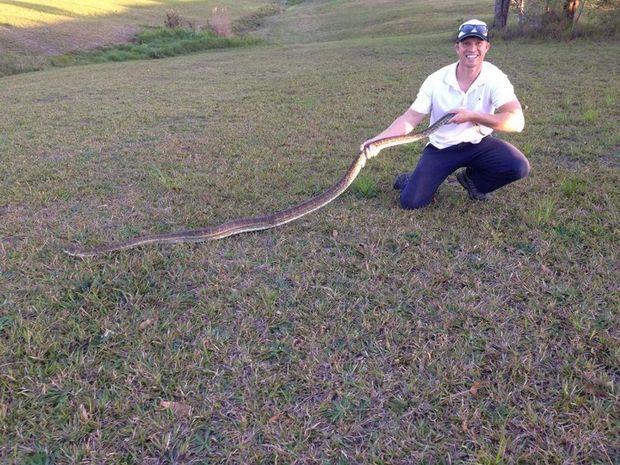
SUNSHINE Coast snake catcher Richie Gilbert has seen it all in more than 13 years on the job.
He's found himself face-to-face with deadly brown snakes and battled with many slippery carpert pythons, including one that went AWOL in his car.
Despite four of Australia's deadliest snakes calling the Sunshine Coast home, Mr Gilbert said he often came across people who could not correctly identify them.
And with 20 snake species living here, it is common for them to pop up in the most unlikely places.
Mr Gilbert has been called in to remove snakes from liquor shops, childcare centres and even family cars, so he felt it was important for Coast residents to be in the know when it came to the reptile population.
So he has put together a handy guide to every snake that can be found on the Sunshine Coast - from the nice to
the particularly nasty.
But he stresses it is only a guide and correct identification should be left to a professional such as himself.
If you need help with a snake, call Mr Gilbert on 0409 536 000.
To learn more, go to www.sunshinecoastsnakecatchers.com.au or follow the Facebook page for tips, videos, identification and general snake education.
YOU SHOULD KNOW
IN Australia there are about 300 snake bites every year, with 200-500 victims receiving anti-venom.
On average, two or three bites will prove fatal.
About half the deaths are due to bites from the brown snake and the rest are mostly from tiger snakes, taipans and death adders.
In most cases, snakes will retreat to nearby cover when disturbed but occasionally will lie still and hope you go
away.
A snake will not make a deliberate move towards you unless it is provoked.
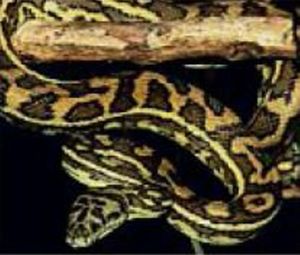
1. Coastal Carpet python
Danger: Non-venomous. Bites may cause substantial lacerations or punctures.
Description: Large, heavy bodied snake with a highly variable, mottled and blocked pattern and colour. Mostly white to cream on the underside.
Average size: 2.3m long but large specimens can exceed 3m. Largest reliable record is 4.2m.
General: Most commonly encountered snake in the region. Often lives in ceilings. Active day and night. Large specimens can devour small pets such as dogs, cats and chickens, with smaller specimens taking caged birds.
Diet: Mostly mammals such as rodents, possums, bats, etc; also some reptiles, birds and frogs.
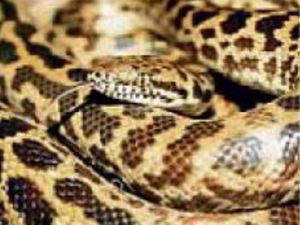
2. Spotted python
Danger: Non-venomous. Bites may cause minor lacerations or punctures.
Description: Solidly-built snake but not as large as the Coastal Carpet python. Fawn or pale-brown ground colour with contrasting dark, chocolatey-brown mottled and blotched pattern and colour. Mostly cream on the underside.
Average size: 75cm-1m. Large specimens may reach 1.5m.
General: Nocturnal. Preferred habitat includes rocky outcrops and associated ridges within dry forests and woodland. Will inhabit areas where ground timber is frequent. Mostly found in the Hinterland it is also infrequently found across the coast in and around mountain areas such as Mt Coolum, Buderim and the Glasshouse Mountains.
Diet: Small mammals, birds and lizards.
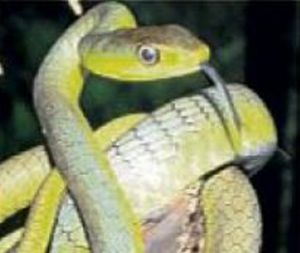
3. Common tree snake
Common names: Green tree snake, yellow-belied black snake, grass snake.
Danger: Non-venomous and bites infrequently. Emits strong odour if threatened.
Description: Sleek slender body with long, thin tail. Colour ranges from green, olive, yellow, brown and black to rare blue-grey on upper body. Belly yellow or creamy, with bright yellow on throat. Some specimens with blue or grey belly. Large eyes.
Average size: 1.2m long and up to 2m.
General: Active by day. The most common species to enter homes on the Sunshine Coast. Fast-moving and hard to see in heavy cover.
Diet: Frogs and skinks but will also take small fish.
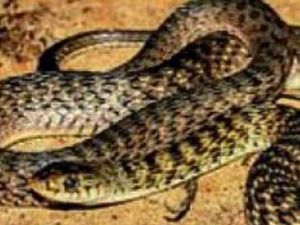
4. Keelback
Common names: Freshwater snake, Water snake, Swamp tiger.
Danger: Non-venomous. Reluctant to bite. Gererally strikes with mouth closed. Emits strong odour when threatened.
Description: Variable colouring but typically shades of grey, brown or olive with irregular, broken cross-bands or flecks of darker brown and flecks of paler creamy colour. Belly surfaces cream or pale rusty colour with dark scale edges. Feature is each scale has a distinct raised longitudinal ridge, giving the snake an appearance of parallel ridges down the length of the body.
Average size: 60cm but can reach 90cm.
General: Active by day and night. Often encountered in suburban homes and yards throughout moist suburbs or areas where creeks and drainage lie.
Diet: Frogs, lizards and occasionally fish and tadpoles. often noted for its ability to eat cane toads.
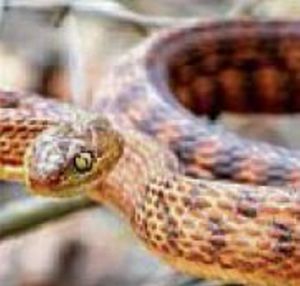
5. Brown Tree snake
Common names: Night tiger, Eastern brown tree snake.
Danger: Mildly venomous. Bites and causes localised pain and swelling and possibly headaches and nausea. Most experts regard it as a minimal risk to all but young children.
Description: Slender-bodied with bulbous head and narrow neck. Large eyes with vertical pupils. Upper brown to reddish-brown or even dark orange, with irregular indistinct darker cross-bands. Belly creamy, apricot or orange.
Average size: 1.2m up to 2m.
General: Strictly nocturnal. Skilled climber often found in the heavy foliage of trees and shrubs and in roofs.
Diet: Birds, bird eggs, small mammals, frogs and reptiles.
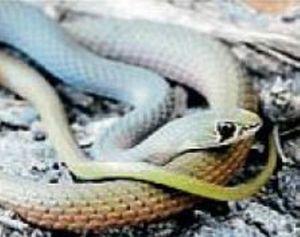
6. Yellow-faced whip snake
Common names: Whip snake, grass snake.
Danger: Potentially dangerous, especially to children. Bite may cause pain and severe symptoms.
Description: Very slender snake with long, thin whip-like tail. Large prominent eyes. Colour generally pale olive or bluish-grey, often with rusty flush or longitudinal stripes along front-third of body. Belly grayish-green, often yellowish under tail. Distinctive face markings. Obvious pale cream or yellow rim around eye, with dark comma-shaped marking curving back below eye.
Average length: 65-70cm but can grow over 90cm.
General: Swift-moving, alert and with good vision; an active hunter by day or hot nights. Quick to retreat. Often seen in suburban yards in and around rock and timber retaining walls.
Diet: Small lizards, frogs and lizard eggs.

7. Lesser black whip snake
Danger: Larger specimens can be potentially dangerous, especially to children. Bite may cause localised pain.
Description: Large prominent eyes. Colour rich dark brown through reddish brown to dark grey, often reddish-brown flush towards tail. Body has pattern of black and white flecks or spots caused by dark and light markings on individual scales. Top of head usually has dark brown spots and flecks, and narrow, pale edge around eye. Belly greenish-grey.
Average size: 1.2m
General: Swift-moving, alert and active by day. Very shy and infrequently encountered.
Diet: Small lizards and frogs.
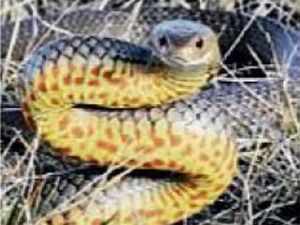
8. Eastern brown
Common names: Common brown snake, brown snake.
Danger: Highly venomous. Accounts for more fatalities than any other Australian snake. A nervous, ready biter it will defend itself if threatened. The second most toxic land snake in the world.
Description: Highly variable in colour and pattern. Colour ranges from pale tan through orange, russet, dark brown and almost black, sometimes with cross-body banding. Belly unusually cream, yellow or orange.
Average size: 1.4m and up to 1.8m.
General: Active hunter by day but active on hot nights. Occasionally climbs in search of prey. Often encountered in and around localities with a strong rodent presence such as bird aviaries and stock feed sheds.
Diet: Primarily small mammals (rats, mice etc.) but also lizards and frogs.
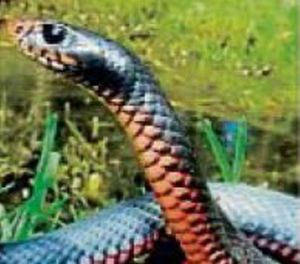
9. Red-bellied black
Danger: Highly venomous.
Description: Uniform glossy black along whole body. Belly has red or pink flush brighter on the sides and paler in the middle. Hind edge of belly scales is black, creating an even red and black striped appearance. Belly colour is visible along flanks and sides.
Average size: 1.5m and up to 2m.
General: Active by day but has been known to be active on hot nights. Favours wet habitats; rain forest and near water. Reclusive but will inflate and flatten the body and neck to intimidate an aggressor. Fearsome reputation is exaggerated.
Diet: Primarily frogs but also other reptiles (including other snakes) and small mammals.
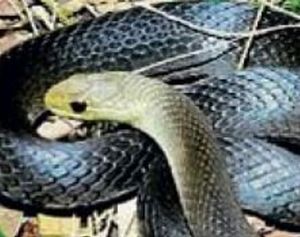
10. Marsh snake
Common names: Black-bellied swamp snake, Swamp snake.
Danger: Mildly venomous. Bites have been known to cause pain and swelling, possible headaches and nausea. Most authorities regard it as a minimal risk to all but children.
Description: Fairly uniform brown, olive or black above with dark grey or black belly surface. Two prominent narrow pale-yellowish stripes on each side of the face, one running from snout through eye and onto neck area, and one below eye running from snout to corner of mouth.
Average size: 50com up to 70cm.
General: Diurnal, although may also be active at night in hot weather. Shelters under rocks and debris. Uncommon throughout most of the region although common near Beerwah.
Diet: Small frogs and lizards.

